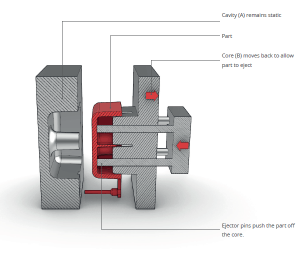The three types of rubber moulding techniques are compression moulding, injection moulding and transfer moulding, here we will have a look at their differences and the benefits they offer.
1. Injection Moulding.
Originally designed as a way to mould plastics, injection moulding was adapted in the sixties to suit rubber. The process of injection moulding starts with the raw unprocessed material being coloured and then pre-cut to a suitable size before being pushed into a double-sided pre-heated mould. The pressure and heat used mean that the rubber sits exactly in the mould, producing a very accurate product with much finer tolerances. The pre-cutting means that there is less trimming of excess flash needed for the finishing. Injection moulding is ideal for large production runs. Once the mould has been made, the need for any pre-forming is eliminated, minimising waste. Small and medium items can be produced in quantity very efficiently with this method.

2. Transfer Moulding.
With transfer moulding, the material is formed into what is known as “pre-forms”. These are introduced into a pot and the mould is enclosed around them. A plunger compresses the rubber into the shape of the mould. Like injection moulding, this process makes an accurate product with minimal flash to be trimmed at the end. The pre-form process means it is better for short production runs of heavier items, and although this method benefits from cost-effective tooling, the advantages of production scale are lost in comparison with injection moulding
3. Compression Moulding.
As with transfer moulding, pre-forms are made, but this time in a slightly larger version of the end product, which is placed in the mould and compressed down to size. The high pressure used means that it is particularly suited for high-density or very hard materials and the pre-forming and subsequent lack of ooze out of wasted material means very expensive rubbers are best processed by this method. It is ideal for small production runs of heavier and bulky items. All of these methods and a good explanation of the various materials and their application can be found here www.meadex.co.uk/rubber-moulding/ a source for rubber moulding UK firms can utilise.

Each method has its optimum use cases and something to recommend it. The choice depends on the material being used, the scale of production, the accuracy required and what is expected of the finished product.
